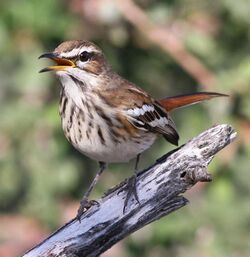Biology:Scrub robin
From HandWiki
Short description: Genus of birds
| Scrub robins | |
|---|---|

| |
| White-browed scrub robin (Cercotrichas leucophrys) | |
| Scientific classification | |
| Domain: | Eukaryota |
| Kingdom: | Animalia |
| Phylum: | Chordata |
| Class: | Aves |
| Order: | Passeriformes |
| Family: | Muscicapidae |
| Genus: | Cercotrichas F. Boie, 1831 |
| Type species | |
| Turdus erythropterus[1] Gmelin, 1789
| |
| Species | |
|
See text | |
The scrub robins or bush chats are medium-sized insectivorous birds in the genus Cercotrichas. They were formerly considered to be in the thrush family, (Turdidae), but are more often now treated as part of the Old World flycatcher family, (Muscicapidae). They are not closely related to the Australian scrub-robins, genus Drymodes in the family Petroicidae.
The genus name Cercotrichas is from Ancient Greek kerkos, "tail" and trikhas, "thrush".[2]
Scrub robins are mainly African species of open woodland or scrub, which nest in bushes or on the ground, but the rufous-tailed scrub robin also breeds in southern Europe and east to Pakistan .
The genus contains the following ten species:[3]
- Karoo scrub robin, Cercotrichas coryphoeus
- Forest scrub robin, Cercotrichas leucosticta
- Bearded scrub robin, Cercotrichas quadrivirgata
- Miombo scrub robin, Cercotrichas barbata
- Black scrub robin, Cercotrichas podobe
- Rufous-tailed scrub robin, Cercotrichas galactotes
- Kalahari scrub robin, Cercotrichas paena
- Brown-backed scrub robin, Cercotrichas hartlaubi
- White-browed scrub robin, Cercotrichas leucophrys
- Brown scrub robin, Cercotrichas signata
References
- ↑ "Muscicapidae". The Trust for Avian Systematics. https://www.aviansystematics.org/4th-edition-checklist?viewfamilies=183.
- ↑ Jobling, James A. (2010). The Helm Dictionary of Scientific Bird Names. London, United Kingdom: Christopher Helm. p. 97. ISBN 978-1-4081-2501-4. https://archive.org/details/Helm_Dictionary_of_Scientific_Bird_Names_by_James_A._Jobling..
- ↑ Gill, Frank; Donsker, David; Rasmussen, Pamela, eds (July 2023). "Chats, Old World flycatchers". IOC World Bird List Version 13.2. International Ornithologists' Union. https://www.worldbirdnames.org/bow/chats/.
Further reading
- Voelker, G.; Peñalbab, J.V.; Huntley, J.W.; Bowie, R.C.K. (2014). "Diversification in an Afro-Asian songbird clade (Erythropygia–Copsychus) reveals founder-event speciation via trans-oceanic dispersals and a southern to northern colonization pattern in Africa". Molecular Phylogenetics and Evolution 73: 97–105. doi:10.1016/j.ympev.2014.01.024. PMID 24508703.
Wikidata ☰ Q2477492 entry
 |

